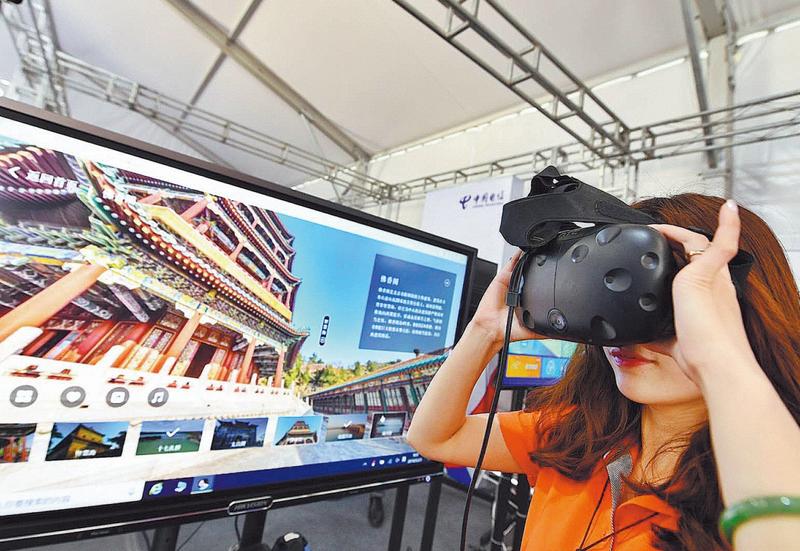District upgrades functions to support Beijing in the 13th Five-Year Plan (2016-20) period
 A woman uses a virtual reality headset to learn about major attractions in Beijing during a science and technology promotion held in the city's Tongzhou district in 2019. The event showcased a series of innovative achievements developed in the city's subcenter. (DENG WEI / FOR CHINA DAILY)
A woman uses a virtual reality headset to learn about major attractions in Beijing during a science and technology promotion held in the city's Tongzhou district in 2019. The event showcased a series of innovative achievements developed in the city's subcenter. (DENG WEI / FOR CHINA DAILY)
During the 13th Five-Year Plan (2016-20) period, Beijing has made marked achievements in developing its subcenter in Tongzhou district across many fields, local officials said.
This year, Tongzhou district's GDP is expected to reach US$17b, with an increase of 57% compared to that at the end of the 12th Five-Year Plan (2011-15) period
The past five years mark a milestone in the subcenter's construction, said Zeng Zanrong, Party secretary of Tongzhou district.
In 2016, the central government issued guidelines on the construction of a subcenter for Beijing, upgrading the status of Tongzhou from a city district to a key part of the coordinated development of the Beijing-Tianjin-Hebei region.
"With further implementation of the plans, the subcenter is developing into a prime demonstration zone that features a friendly environment, green development, a new type of urbanization and the coordinated development of the Beijing-Tianjin-Hebei region," Zeng said.
A number of city government departments have moved to the subcenter's administrative area.
ALSO READ: Key projects push Zhanjiang forward as subcenter
The subcenter is seizing the opportunity of relocating industries from downtown Beijing to gather resources and seek high-quality development, Zeng said.
This year, Tongzhou district's GDP is expected to reach 108 billion yuan (US$17 billion), with an increase of 57 percent compared to that at the end of the 12th Five-Year Plan (2011-15) period.
In the past five years, the authorities have continued exploring the subcenter's high-quality development in technological innovation, commercial service and cultural tourism.
The number of national-level high-tech companies in the subcenter has increased by 668 between 2015-19, to 1,077.
Pollution control has been prioritized in the development of the subcenter, according to Zeng.
"We have made unprecedented efforts to control air and water pollution," he said.
Official data shows that the accumulated concentration of PM2.5-particulate matter with a diameter of 2.5 micrometers or less-has decreased by 60 percent compared with that of 2015. The forest coverage rate has reached 33 percent, an increase of 5.7 percentage points from five years ago, and a forest park opened to the public in September.
With the building of infrastructure and administrative facilities, the urban operation capabilities of the subcenter have improved, Zeng said.
Subway Line 7 eastern extension and Batong Line southern extension have been put into operation and the district's road network density has expanded from 3.54 kilometers per square kilometer at the end of the 12th Five-Year Plan period to 4 km for each sq km.
A total of 14 electrical substations have been built, with the power supply's support capability increased by 30 percent. A new water plant has been put into operation in Tongzhou capable of supplying 375,000 metric tons of water each day.
"We have put equal emphasis on constructing and managing, adding facilities and enhancing service to increase the city enchantment," Zeng said.
Local authorities have expanded administrative services via information technology and shared data, as part of efforts to realize smart urban management.
With an expanding population, the subcenter has also seen an improvement in its social welfare services.
The Beijing Friendship Hospital of Capital Medical University and the Dongzhimen Hospital of Beijing University of Chinese Medicine operate branches in Tongzhou district.
More than 10 schools including the High School Affiliated to Renmin University of China have opened in the district.
In the past five years, the registered urban unemployment rate has been within 3.5 percent, and the renewal rate for old-age insurance was maintained at more than 96 percent, according to Zeng.
In addition, the subcenter has improved 140 backstreets and promoted the renovation of 21 old communities. It has carried out environmental governance measures on 360 villages, helping farmers increase their incomes.
READ MORE: Transport hub to feed Beijing subcenter
Zheng Hao, deputy head of Tongzhou district, said the subcenter is implementing its development blueprint, putting vision into actions.
In the next five years, the subcenter will build more urban facilities including those for cultural tourism, according to Zheng.
According to its plans, the subcenter will carry out 388 major urban projects and conduct 165 programs to renovate and upgrade old towns.
"In the 14th Five-Year Plan (2021-25) period, we will continue to promote the high-quality development of the subcenter with the spirit of craftsmanship," she said.


